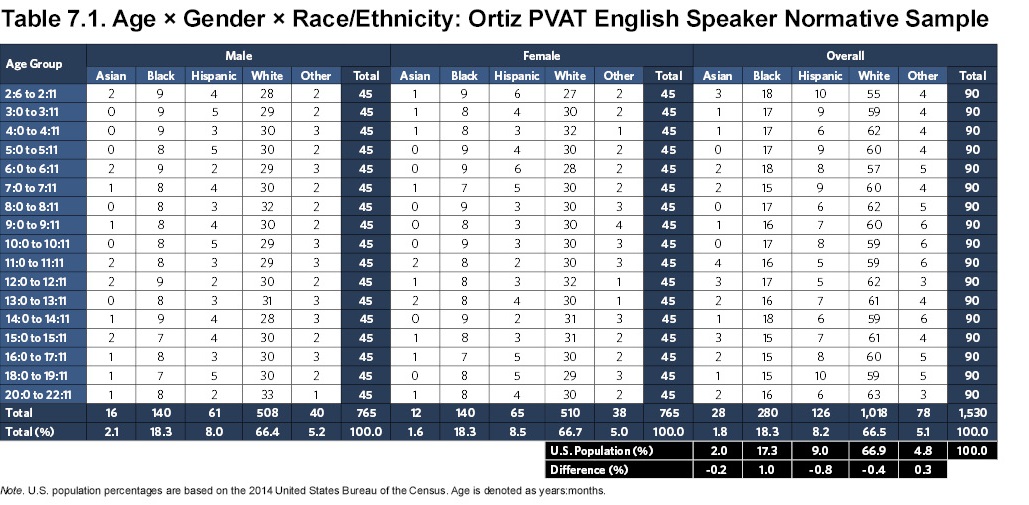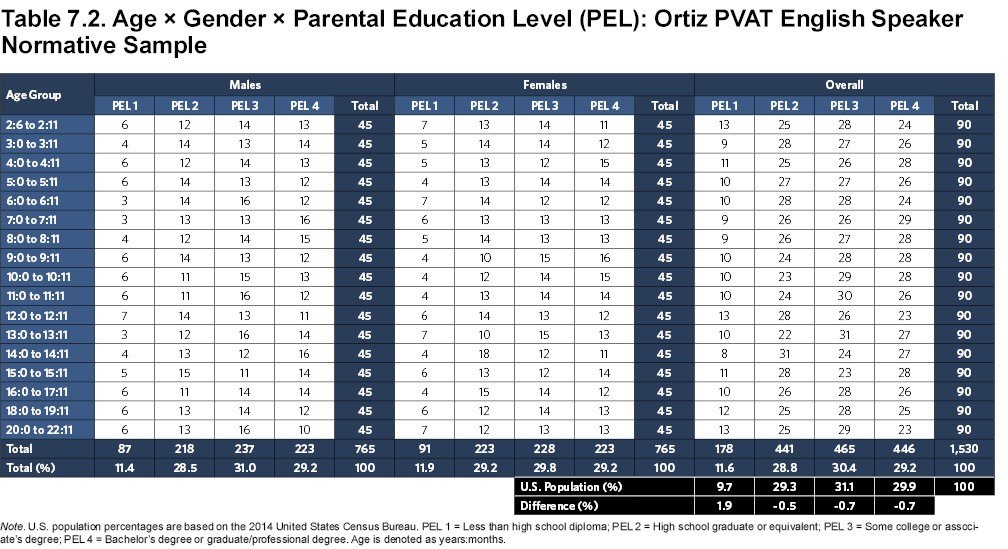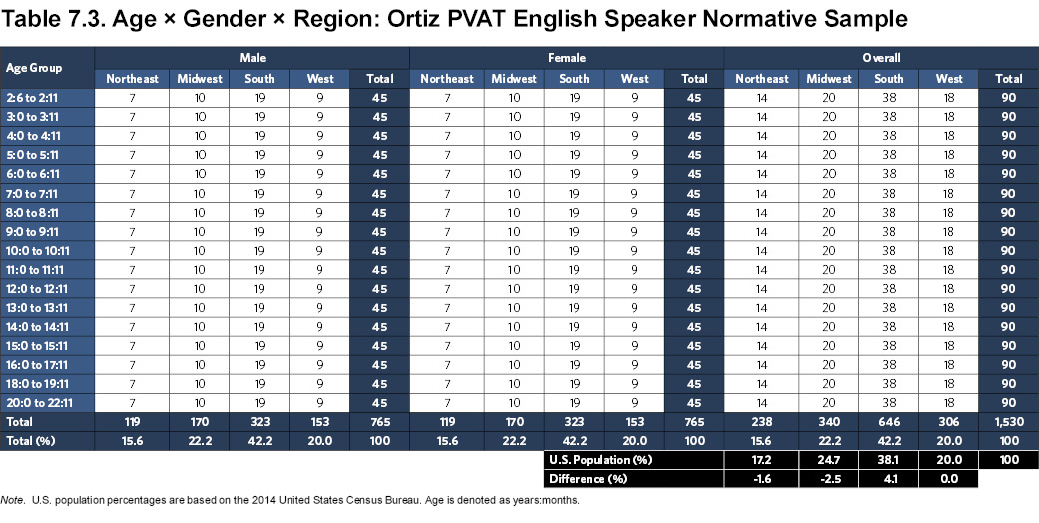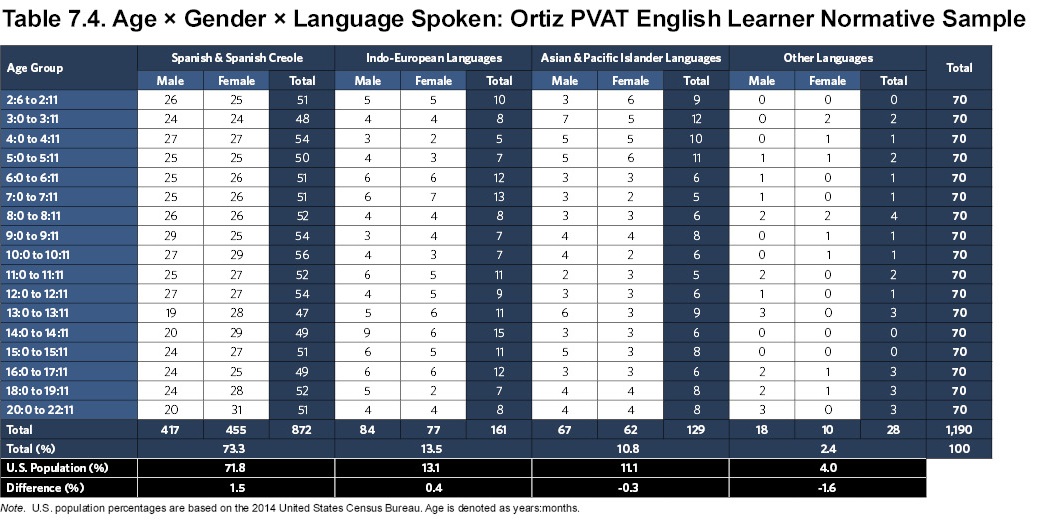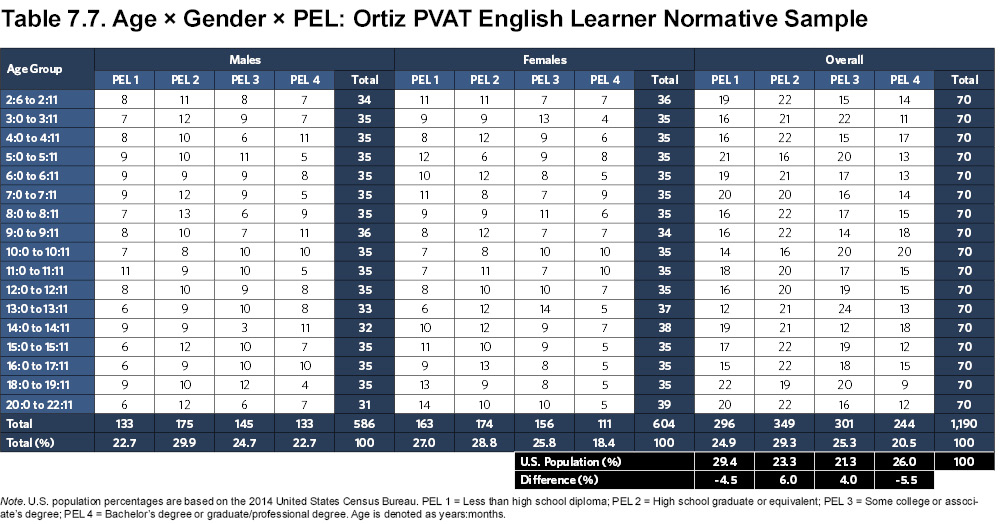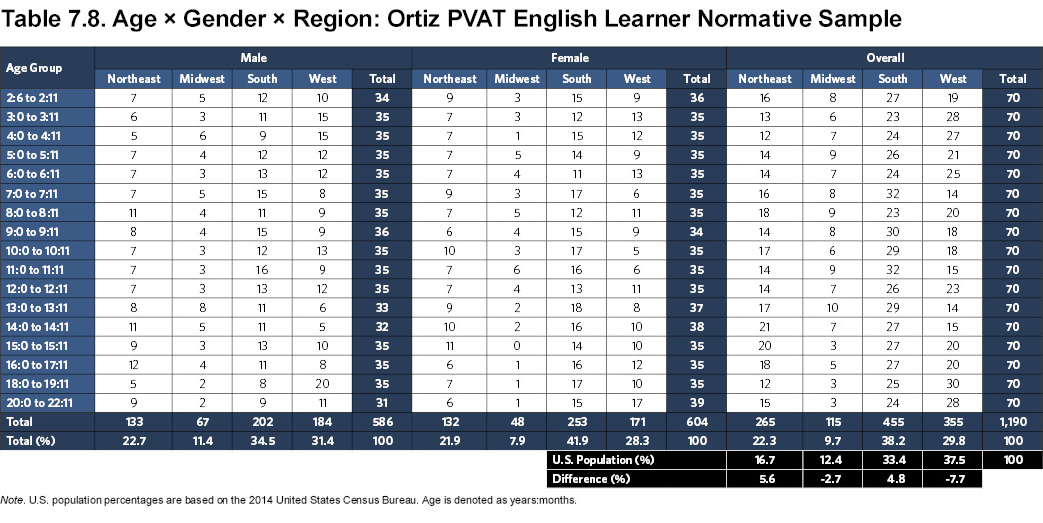- Technical Manual
- Chapter 1: Introduction
- Chapter 2: Theory and Background
- Chapter 3: Administration and Scoring
- Chapter 4: Scores and Interpretation
- Chapter 5: Case Studies
- Overview
- Case Study 1: Clinical Evaluation of an English Speaker Suspected of Having a Speech-Language Impairment
- Case Study 2: Progress Monitoring of an English Learner with Suspected Deficits in Verbal Ability and Language
- Case Study 3: Psychoeducational Evaluation of an English Learner with Suspected Specific Learning Disability
- Chapter 6: Development
- Chapter 7: Standardization
- Chapter 8: Test Standards: Reliability, Validity, and Fairness
- Task Instructions Scripts
Description of Normative Samples |
Two general population normative samples were collected. As discussed in chapter 2, Theory and Background, it is critical to compare individuals to an appropriate reference group to ensure valid and appropriate interpretation of results. In the case of vocabulary acquisition, important differences exist between individuals who have been learning English exclusively since birth and individuals who have been learning a different language since birth but who have also been exposed to English at some point. Accordingly, representative samples for each group were collected in the development of the Ortiz PVAT.
English Speaker Normative Sample
The English Speaker normative sample was collected to match the demographic characteristics of English speakers in the U.S. population (based on the 2014 American Community Survey [ACS] conducted by the U.S. Census Bureau). English speakers, as determined by the ACS, were defined as those who endorsed “Speak only English” as their language spoken at home. Gender was balanced within each age group, and target demographic variables of race/ethnicity, geographic region, and parental education level (PEL) were collected using a stratified sampling plan to ensure representativeness. In total, 1,530 individuals were included in the normative sample.
Due to the requirement of audio and visual processing to complete the task, individuals were excluded from the sample if they had either a hearing impairment that may affect their ability to hear or process speech sounds, or any visual impairment that cannot be corrected with glasses or contact lenses. Individuals who do not use spoken language to communicate, along with those who have been diagnosed with a psychological, behavioral, and/or learning disorder, or were receiving special education services of any kind, were also excluded from the normative sample. In addition, individuals were not eligible for inclusion in the English Speaker normative sample if they had spoken a language other than English as their first language, if they attended school where English was not the primary language of instruction, or if any language other than English was spoken in the home. Furthermore, the individual’s parents or guardians must have been born in a primarily English-speaking country (e.g., U.S., Canada, Australia, or South Africa).
The following is a description of each of the target demographic variables for the English Speaker normative sample.
Age
Individuals aged 2 years 6 months (2:6) through 22 years 11 months (22:11) were eligible to participate in the standardization process. The English Speaker normative sample comprised 90 individuals in each of the 17 age groups (see Table 7.1).
Gender
Within each age range, male and female participants were evenly balanced (n = 45 for each gender; see Table 7.1). Gender was also closely balanced within each finer stratification level (i.e., age by race/ethnicity, age by PEL, age by region).
Race and Ethnicity
During data collection, the Ortiz PVAT included a demographic question that classified the participant’s race/ethnicity as Asian/Pacific Islander, Black/African American, Hispanic/Latino/Latina, Native/Aboriginal, White, Multiracial, or Other. For ease of presentation, the following race/ethnic group labels will be used in this manual: Asian, Black, Hispanic, White, Other (includes Multiracial and Native/Aboriginal). These same groups were used in the development of the stratification plan, which was derived from proportions observed in the U.S. Census. The distribution of race/ethnicity by age and gender is provided in Table 7.1. The overall proportions of race/ethnicity within the English Speaker sample very closely matched the U.S. population, differing by no more than 1%. Race/ethnicity was also stratified by geographic region and PEL according to the proportions provided by the 2014 U.S. Census Bureau.
Parental Education Level
Information about the highest level of education achieved by the primary parent/guardian was obtained for each individual. Four PEL groups were collected: (1) No high school diploma, (2) High school graduate or equivalent, (3) Some college or associate’s degree, and (4) Bachelor’s degree or graduate/professional degree. The distribution of PEL by age and gender is provided in Table 7.2. The overall proportions of PEL in the English Speaker normative sample very closely matched the U.S. population (within 2%).
Region
The U.S. Census regions (Northeast, Midwest, South, and West) were used to divide the sample based on residence of the participant. The distribution of region by age and gender is provided in Table 7.3. The proportion of cases within the English Speaker normative sample from each region closely (within 5%) approximated the U.S. population.
Conclusions: Representativeness of the English Speaker Normative Sample
The English Speaker normative sample for the Ortiz PVAT is representative of the U.S. population for individuals aged 2 years 6 months to 22 years 11 months for whom English is the only language spoken at home, in accordance to the most recent U.S. Census available at the time of data collection. Age and gender were evenly balanced, and the target demographic variables of race/ethnicity, PEL, and region were carefully stratified and matched to the 2014 U.S. Census Bureau figures, as described above. Specifically, at the overall level, the proportions of each target demographic differ between the English Speaker normative sample and the U.S. population by less than 5%. Even within each age group, the demographic characteristics correspond to proportions found in the U.S. population.
English Learner Normative Sample
The English Learner normative sample was collected to match the demographic characteristics of individuals in the U.S. population with exposure to a language other than English, based on the 2014 American Community Survey conducted by the U.S. Census Bureau. Census values were derived from individuals aged 5 to 18 years who indicated “Speak a language other than English” for their language spoken at home. Gender was balanced within each age group, and the target demographic variables of primary language spoken in the home, geographic region, and PEL were collected using a stratified sampling plan to ensure representativeness. In total, 1,190 individuals were included in the normative sample.
Due to the task requirement of audio and visual processing, individuals were excluded from the sample if they had either a hearing impairment that may affect their ability to hear or process speech sounds, or any visual impairment that cannot be corrected with glasses or contact lenses. Individuals who do not use spoken language to communicate were also excluded from the normative sample. In addition, individuals who have been diagnosed with a psychological, behavioral, and/or learning disorder, or are receiving special education services of any kind, were excluded from the sample. Inclusion in the English Learner normative sample also required that the individual’s first language was either a language other than English or English in combination with another language, and that they had exposure to a language other than English (e.g., through parents/guardians and relatives, media and the community, or formal academic instruction for the majority of their school day).
The following is a description of each of the target demographic variables for the English Learner normative sample.
Age
Individuals between 2 years 6 months (2:6) and 22 years 11 months (22:11) were eligible to participate in the standardization process. The English Learner normative sample comprised 70 individuals at each of the 17 age ranges (see a breakdown of this sample by age in Table 7.4).
Gender
Within each age range, the number of male and female participants was closely balanced (see Table 7.4). Overall, the English Learner normative sample consists of 49.2% male participants and 50.8% female participants.
Language Spoken and Exposure to English
Participants provided detailed information on the first language they learned, and their responses were then classified into four major language groups that aligned with census data on world languages. The four categories for language are Spanish & Spanish Creole, Indo-European languages (e.g., German, Greek, French, Punjabi; note that this includes all other Indo-European languages other than Spanish), Asian & Pacific Islander languages (e.g., Cantonese, Indonesian, Korean, Tagalog), and Other languages (e.g., Arabic, Finnish, Hebrew, Navajo). In total, 53 different languages were represented in the English Learner normative sample.
Efforts were taken to ensure a wide range of exposure to English within each of these language groups. Individuals reported the number of years they had been exposed to English; length of exposure ranged from 0–3 months to more than 16 years. Since no census data exists on length of exposure to English, a sufficient number of participants at each exposure level was collected to ensure representativeness. Table 7.5 presents the English Learner normative sample’s exposure to English in terms of absolute duration (i.e., number of years with exposure to English, categorized into 11 levels of exposure), and Table 7.6 presents the sample’s exposure to English in terms of relative duration (i.e., percentage of life exposed to English, categorized into five levels). Given the specificity of the English Learner normative sample, the individual’s first language spoken was prioritized in the stratification and correspondence with the U.S. Census (matched within 2%), followed by PEL and region, which were matched to the U.S. Census figures where possible.
Parental Education Level
Information about the parent or guardian’s highest level of education achieved was obtained for each individual. Four PEL groups were collected: (1) No high school diploma, (2) High school graduate or equivalent, (3) Some college/university or associate’s degree, and (4) Bachelor’s degree or graduate/professional degree. Stratification of PEL was designed to closely mirror proportions identified in the U.S. Census, balanced across age and gender (see Table 7.7). The overall proportions of PEL in the English Learner normative sample was a close match (within 6%) to the U.S. population proportions.
Region
The U.S. Census regions (Northeast, Midwest, South, and West) were used to divide the sample based on residence of the participant. The distribution of region by age and gender is provided in Table 7.8. The proportion of cases within the English Learner normative sample from each region approximated the U.S. population within 8% of the U.S. Census values.
Conclusions: Representativeness of the English Learner Normative Sample
The English Learner normative sample for the Ortiz PVAT is representative of the U.S. population for children and adolescents aged 2 years 6 months to 22 years 11 months for whom English is not the primary language spoken at home. This sample was distributed across a wide range of exposure to English, and individuals in this sample spoke a variety of languages other than English. Age and gender were evenly balanced, and the target demographic characteristics of language spoken, PEL, and region were carefully stratified and matched to the 2014 U.S. Census Bureau figures, as described above. Overall, the proportions of each target demographic differ between the English Learner sample and the 2014 U.S. population by less than 8%. Within each age group, the distributions of demographic groups are consistent with the U.S. population.
| << Data Collection Procedures | Standardization Procedures >> |






